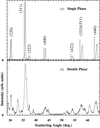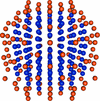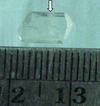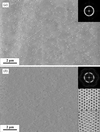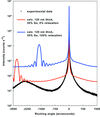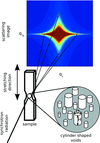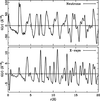issue contents
June 2010 issue

Cover illustration: PDB_REDO optimization of the oldest structure with experimental data in the PDB [155c; Timkovich & Dickerson (1976). J. Biol. Chem. 251, 4033-4046]. Front: final structure - warmer colours show greater atomic displacement. Back: final structure model with atomic trajectories in yellow. Courtesy of Joosten et al. [J. Appl. Cryst. (2009), 42, 376-384].
research papers
The structure of multilayered thin films – composed of layers of spherical PbTe nanocrystals embedded in an SiO2 matrix – is studied by grazing-incidence small-angle X-ray scattering.
Download citation


Download citation


As part of a study of the long-term operation of solid-oxide fuel cells, three (Mn,Co,Cr)3O4 samples have been synthesized and characterized using X-ray and neutron diffraction on powder samples at room temperature. The data were co-refined.
Local minimization algorithms have been used to solve two moderately complex molecular crystal structures from powder diffraction data. The results are used to characterize the χ2 agreement surface and provide a benchmark against which the performance of other optimization algorithms can be assessed.
The compressibility of several proteins and polynucleotides was determined by high-pressure single-crystal diffraction.
A precipitate and its parent crystal always establish a specific crystallographic relationship in which the differences in the g-vector pairs (Δg) of the two structures are aligned in the same direction, and the precipitate exhibits a growth habit plane normal to Δg. This normal-to-Δg principle is formulated to calculate the optimum interphase boundaries in several mineral systems.
It is demonstrated that distributions of intermolecular distances and angles should be properly normalized to highlight their chemical meaning.
Anion-exchange reactions involving carbonate, chloride, nitrate and sulfate layered double hydroxides were studied in situ by synchrotron X-ray powder diffraction.
A simplified invariant line analysis for face-centred cubic/body-centred cubic precipitation systems
A simplified invariant line analysis for face-centered cubic/body-centered cubic precipitation systems is proposed. This simplified analysis makes the application of phase transformation theory more understandable and highly efficient.
A dynamical theory calculation, based on Bloch wave expansion, is developed to explain spin-scho resolved grazing incidence scattering measurements on a diffraction grating. The theory provides a detailed description of the scattering process and the behavior of the neutron wavefunction in the vicinity of the grating.
In situ X-ray diffraction has been used to investigate goethite-seeded Al(OH)3 precipitation from synthetic Bayer liquor at 343 K. Rietveld-based quantitative phase analysis has allowed for the determination of the absolute phase abundances of the precipitated phases and for the determination of kinetic information.
Mechanical vibration was found to affect crystal morphology and crystallization screening, showing that it could be utilized in practical protein crystallization to obtain better faceted crystals and yield more crystallization conditions.
Estimation of the features of an ensemble of Au nanoparticles using pair distribution function data is investigated via optimization of a model function calculated by simulation of an ensemble of particles.
Significant improvement of crystalline perfection in L-asparagine monohydrate single crystals was achieved by annealing. As a result of the improvement in crystalline perfection, remarkable enhancement in second harmonic generation efficiency, optical transparency, fluorescence intensity and dielectric properties was observed.
The variable-temperature X-ray diffraction results of the β(001), α(101) and α(103) lattice planes of one-dimensional Ta2O5 nanorods showed complex and polymorphic thermochromic phase transformations, which incorporate α-to-α (α–α), α–α–β and α–β phase transitions at elevated temperatures ranging from 80 to 300 K. The d-spacing expansions of the lattice planes can explain the thermochromic phase transformations between α- and β-phase crystals.
Parametric Rietveld refinement is extended to variable-pressure powder diffraction data. Different approaches to parameterization are described and compared.
A thermosyphon-driven flow-through cell has been designed and constructed for hydrothermal crystallization studies by the in situ and time-resolved neutron diffraction technique, and has been demonstrated by the hydrothermal transformations between KAlSi2O6 and NaAlSi2O6·H2O on the high-intensity powder diffraction beamline WOMBAT at the Australian Nuclear Science and Technology Organization (ANSTO). The cell is located at ANSTO and is open to worldwide users.
A new theory describing the coherent and diffuse X-ray scattering in non-ideal crystals modulated by a surface acoustic wave is presented. The calculated reciprocal space maps and rocking curves are compared with the corresponding experimental results.
Microradian X-ray diffraction shows that the porous structure of anodic alumina films possesses long-range orientational order and very extended longitudinal self-correlations, while the interpore positional order is rather short-range, not more than ∼10 interpore distances.
A new algorithm to extend three-dimensional X-ray diffraction analysis of grain resolved properties to include the characterization of grain resolved stresses is presented. The algorithm has been applied to both simulated and experimental data to validate the obtained results.
A modified method for implementing statistical dynamic diffraction theory is presented, along with its application to structurally defective semiconductor heterostructures.
The corrections necessary to conduct and analyze fixed incident angle reflection geometry experiments with a curved position-sensitive detector are provided.
A newly designed neutron guide system for the macromolecular diffractometer (MaNDi) at the Spallation Neutron Source is described, along with large-area high-resolution neutron detectors. Monte Carlo techniques used to simulate diffraction from large unit cells are also detailed.
The broadening of X-ray and electron diffraction peaks due to helicoidal twist of lamellar crystals is analyzed in the limit of small natural reflection width. The proposed approach can be useful for interpretation of microbeam diffractograms measured on banded polymer spherulites.
Simulation of kinematic diffraction from a thin Si film illuminated by a coherent, focused X-ray nanobeam is presented and compared with experimental data measured at the nanoprobe instrument at Sector 26 of the Advanced Photon Source.
All possible misorientations induced in commercially pure titanium during cold-rolling as a result of the combination of two twinning systems have been calculated and compared with the experimentally observed twin configurations. A 41° misorientation has been identified as resulting from the development of tensile twins inside primary compressive twins.
A model is introduced to evaluate the scattering of randomly distributed micro-voids which are aligned along a given direction and show a log-normal size distribution.
Open  access
access
 access
accessAfter autoindexing, Bragg spot candidates that do not fit on the model lattice can be identified, providing a potentially useful measure of sample quality and giving an avenue for indexing a second lattice, if one is present.
Using automated electron backscatter diffraction, a new approach is presented for the comprehensive and unambiguous determination of twin relationships in a 7M modulated Ni–Mn–Ga alloy.
A method is presented for crystal structure solution from atomic pair distribution function data.
short communications
Open  access
access
 access
accessA study of the structure of micelles of the surfactant polysorbate 80 in aqueous dimethyl sulfoxide solutions shows that the micelles change from core–shell cylinder micelles to core–shell discus micelles between concentrations of 20 and 30% dimethyl sulfoxide.
A simple, physically-based model which uses up to three refinable parameters to fit peak profiles is presented. The use of this model reduces the total number of parameters required to fit the observed peak profiles, hence leading to increased stability during profile analysis.
computer programs
MIXSCAT is a user-friendly program to extract differential pair distribution functions from neutron and X-ray data.
Scatter is a new software for analysis, modeling and fitting of scattering curves and scattering patterns of non-ordered, partially ordered or fully ordered nano- and mesoscale structures.
This paper shows how the power of graphics processing units can be exploited to compute the powder diffraction pattern of nano-sized objects.
laboratory notes
It is shown that for a stress instrument with small monochromator take-off angle (∼30°) the maximum figure of merit for angular accuracy of the diffraction line position, which is comparable to the instrument having a take-off angle of ∼55°, can be achieved by optimizing a focusing Si(111) bent perfect crystal monochromator.
crystallographers
Free 

book reviews
Free 



 journal menu
journal menu












